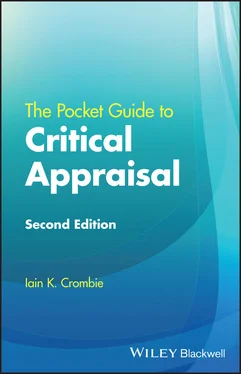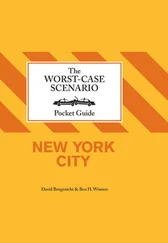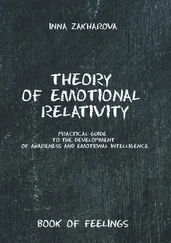1 Cover
2 Title Page The Pocket Guide to Critical Appraisal SECOND EDITION Iain K. Crombie University of Dundee Dundee, UK
3 Copyright
4 Acknowledgements
5 Preface to the First Edition
6 Preface to the Second Edition
7 CHAPTER 1: Introduction to Critical Appraisal The aims of critical appraisal Three stages of critical appraisal
8 CHAPTER 2: Do Not Read the Paper The initial interrogation The in‐depth interrogation
9 CHAPTER 3: Identifying the Research Design Surveys Cohort studies Case–control studies RCTs Cohort studies that evaluate the effectiveness of interventions Systematic reviews
10 CHAPTER 4: Interpreting the Results The effect size Taking the play of chance into account Factors that distort the effect size Questionable research practices Conclusion
11 CHAPTER 5: The In‐Depth Interrogation Bias Critical questions for bias Important questions for bias Indicative questions for bias Questions about value Conclusion
12 CHAPTER 6: Appraising Surveys The critical bias questions for bias The complete list for appraising surveys*
13 CHAPTER 7: Appraising Cohort Studies The critical questions for bias The important questions for bias The indicative questions for risk of bias The complete list for the appraisal of cohort studies*
14 CHAPTER 8: Appraising Case–Control Studies The critical questions for bias The important questions for bias The complete list for the appraisal of case–control studies*
15 CHAPTER 9: Appraising Randomised Controlled Trials The critical questions for bias The important questions for bias The questions of value The complete list for the appraisal of clinical trials*
16 CHAPTER 10: Cohort Studies That Evaluate the Effectiveness of Interventions Overview of advantages of cohort treatment studies and challenges for critical appraisal The critical questions for bias The important questions for bias The questions of value Conclusion The complete list for the appraisal of cohort studies that evaluate interventions
17 CHAPTER 11: Appraising Systematic Reviews The critical questions for risk of bias The important questions for risk of bias The questions of value The complete list for the appraisal of systematic reviews*
18 CHAPTER 12: Summarising Risk of Bias Identify the risk of bias of the research designs Review the biases in study design, conduct, and interpretation Derive an overall rating Summary
19 CHAPTER 13: Certainty of Evidence The nature of certainty of evidence Downgrading the certainty of evidence Factors that increase certainty Overall assessment of certainty Conclusion
20 CHAPTER 14: Assessing Value Measuring potential benefit Harm and the balance between benefit and harm Costs and cost effectiveness Feasibility of implementation of a treatment Health equity Summary
21 Appendix: Further Reading Chapter 1: Introduction Chapter 3: Identifying the research design Chapter 4: Interpreting the results Chapter 5: The in‐depth interrogation Chapter 6: Appraising surveys Chapter 7: Appraising cohort studies Chapter 8: Appraising case–control studies Chapter 9: Appraising randomised controlled trials Chapter 10: Cohort studies that evaluate the effectiveness of interventions Chapter 11: Appraising systematic reviews Chapter 12: Summarising risk of bias Chapter 13: Certainty of evidence Chapter 14: Assessing value
22 Index
23 End User License Agreement
1 Chapter 12TABLE 12.1 Initial ranking of the research designs.TABLE 12.2 Illustration of an assessment of risk of bias in an RCT.
1 Cover Page
2 Table of Contents
3 Title Page The Pocket Guide to Critical Appraisal SECOND EDITION Iain K. Crombie University of Dundee Dundee, UK
4 Copyright
5 Acknowledgements
6 Preface to the First Edition
7 Preface to the Second Edition
8 Begin Reading
9 Appendix: Further Reading
10 Index
11 Wiley End User License Agreement
1 iv
2 ix
3 xi
4 xiii
5 xiv
6 1
7 2
8 3
9 4
10 5
11 6
12 7
13 8
14 9
15 10
16 11
17 12
18 13
19 14
20 15
21 16
22 17
23 18
24 19
25 20
26 21
27 22
28 23
29 24
30 25
31 26
32 27
33 28
34 29
35 30
36 31
37 32
38 33
39 34
40 35
41 36
42 37
43 38
44 39
45 40
46 41
47 42
48 43
49 44
50 45
51 46
52 47
53 48
54 49
55 50
56 51
57 52
58 53
59 54
60 55
61 56
62 57
63 58
64 59
65 60
66 61
67 62
68 63
69 64
70 65
71 66
72 67
73 68
74 69
75 70
76 71
77 72
78 73
79 74
80 75
81 76
82 77
83 78
84 79
85 80
86 81
87 82
88 83
89 84
90 85
91 86
92 87
93 88
94 89
95 90
96 91
97 92
98 93
99 94
100 95
101 96
102 96
103 97
104 98
105 99
106 100
107 101
108 102
109 103
110 104
111 105
112 106
113 107
114 108
115 109
116 110
117 111
118 112
119 113
120 114
121 115
122 116
123 117
124 118
125 119
126 120
127 121
128 122
129 123
130 124
131 125
132 126
133 127
134 128
135 129
136 131
137 132
138 133
139 134
140 135
141 136
142 137
143 138
144 139
145 140
146 141
The Pocket Guide to Critical Appraisal
SECOND EDITION
Iain K. Crombie
University of Dundee Dundee, UK

This second edition first published 2022
© 2022 John Wiley & Sons Ltd
All rights reserved. No part of this publication may be reproduced, stored in a retrieval system, or transmitted, in any form or by any means, electronic, mechanical, photocopying, recording or otherwise, except as permitted by law. Advice on how to obtain permission to reuse material from this title is available at http://www.wiley.com/go/permissions.
The right of Iain K. Crombie to be identified as the author of this work has been asserted in accordance with law.
Registered Offices
John Wiley & Sons, Inc., 111 River Street, Hoboken, NJ 07030, USA
John Wiley & Sons Ltd, The Atrium, Southern Gate, Chichester, West Sussex, PO19 8SQ, UK
Editorial Office
9600 Garsington Road, Oxford, OX4 2DQ, UK
For details of our global editorial offices, customer services, and more information about Wiley products visit us at www.wiley.com.
Wiley also publishes its books in a variety of electronic formats and by print‐on‐demand. Some content that appears in standard print versions of this book may not be available in other formats.
Limit of Liability/Disclaimer of Warranty:The contents of this work are intended to further general scientific research, understanding, and discussion only and are not intended and should not be relied upon as recommending or promoting scientific method, diagnosis, or treatment by physicians for any particular patient. In view of ongoing research, equipment modifications, changes in governmental regulations, and the constant flow of information relating to the use of medicines, equipment, and devices, the reader is urged to review and evaluate the information provided in the package insert or instructions for each medicine, equipment, or device for, among other things, any changes in the instructions or indication of usage and for added warnings and precautions.
Читать дальше













